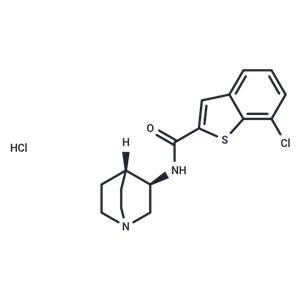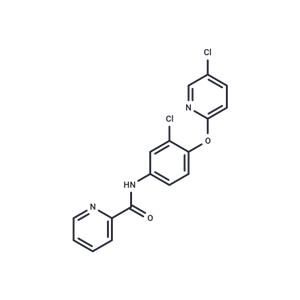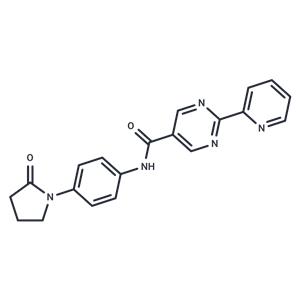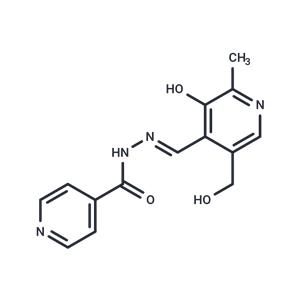| Name | Encenicline |
| Description | Encenicline (EVP-6124) is a selective α7 nicotinic acetylcholine receptor (nAChRs) agonist being developed to treat cognitive impairment in schizophrenia and Alzheimer's disease. |
| Cell Research | Experiments were carried out with human a7 nAChRs expressed in Xenopus laevis oocytes.?Oocytes were prepared, injected with cDNA encoding a7 nAChR subunits, and recorded using standard procedures.?Additional studies were carried out with rat a3b4, a4b2, and muscle a1b1gd nAChRs expressed in oocytes.?Briefly, ovaries were harvested from X. laevis females that were deeply anesthetized by cooling at 4℃ and with tricaine mesylate (3-aminobenzoic acid ethyl ester, methane sulfonate salt, 150 mg/l).?Small pieces of ovary were isolated in sterile Barth solution (88 mM NaCl, 1 mM KCl, 2.4 mM NaHCO3, 10 mM HEPES, 0.82 mM MgSO4·7H2O, 0.33 mM Ca(NO3)2·4H2O, and 0.41 mM CaCl2·6H2O, pH 7.4) and supplemented with 20 mg/ml kanamycin, 100 μg/ml penicillin, and 100 mg/ml streptomycin.?Injections of cDNAs encoding for the receptors were performed in at least one hundred oocytes using an automated ?injection device;?and receptor expression was examined at least two days later.?Oocytes were impaled with two electrodes filled with 3 M KCl, and their membrane potentials were ?maintained at ?80 mV throughout the experiment.?All recordings were performed ?at 18 C and cells were superfused with OR2 medium (82.5 mM NaCl, 2.5 mM KCl, 5 mM HEPES, 1.8 mM CaCl2·2H2O, and 1 mM MgCl2·6H2O, pH 7.4).?Currents were recorded using an automated process equipped with standard two-electrode voltage-clamp configuration.Data were captured and analyzed using Matlab or Excel software.ACh and EVP-6124 were prepared as concentrated stock solutions in water and then diluted in the recording medium to obtain the desired test concentrations.?All experiments were carried out using three or more cells[1]. |
| Animal Research | For the experiments using natural forgetting (a 24 h retention interval) and MLA, twenty-four 2-month-old male Wistar rats .?In the doseeresponse experiment, the rats were 2.5 months old (average body weight: 319 g). For the coadministration of EVP-6124 and MLA , the rats were 3 months old (average body weight: 357 g). For the co-administration of EVP-6124 and MLA, the rats were 4 months old (average body weight: 407 g). Across the 3 experiments, rats were tested a total of 5e10 times.?The effects of EVP-6124 on memory consolidation in particular were investigated in the natural forgetting test in the ORT, using twentyfour 3-month-old Wistar rats (average body weight: 357 g). All 24 rats received each treatment, i.e. each rat was tested 7 times in two experiments.?All animals were housed individually, which improves ORT performance, in standard type III Makrolon cages on sawdust bedding.?The animals were on a reversed 12/12-h light/dark cycle (lights on from 19:00 to 7:00 h);?and food and water were given ad libitum.?The rats were housed and tested in the same room.?A radio, playing softly provided background noise to mask noises in the room.?All testing was performed between 9:00 and 18:00 h under low illumination (20 lux)[1]. |
| In vitro | In co-application experiments of EVP-6124 with acetylcholine, sustained exposure to EVP-6124 in functional investigations in oocytes caused desensitization at concentrations greater than 3 nM, while lower concentrations (0.3-1 nM) caused an increase in the acetylcholine-evoked response.?These actions were interpreted as representing a co-agonist activity of EVP-6124 with acetylcholine on α7 nAChRs.?The concentrations of EVP-6124 that resulted in physiological potentiation were consistent with the free drug concentrations in brain that improved memory performance in the ORT[2]. |
| In vivo | EVP-6124 showed selectivity for α7 nAChRs and did not activate or inhibit heteromeric α4β2 nAChRs.?EVP-6124 had good brain penetration and an adequate exposure time.?EVP-6124 (0.3 mg/kg) significantly restored memory function in scopolamine-treated rats (0.1 mg/kg) in an object recognition task (ORT).?Although donepezil at 0.1 mg/kg, p.o. or EVP-6124 at 0.03 mg/kg, p.o. did not improve memory in this task, co-administration of these sub-efficacious doses fully restored memory.?In a natural forgetting test, an ORT with a 24 h retention time, EVP-6124 improved memory at 0.3 mg/kg, This improvement was blocked by the selective α7 nAChR antagonist methyllycaconitine (0.3 mg/kg or 10 μg)[1]. |
| Storage | Powder: -20°C for 3 years | In solvent: -80°C for 1 year | Shipping with blue ice. |
| Solubility Information | DMSO : 60 mg/mL (187.01 mM)
|
| Keywords | inhibit | nAChR | Nicotinic acetylcholine receptors | EVP 6124 | Encenicline | EVP6124 | Inhibitor |
| Inhibitors Related | Adiphenine hydrochloride | Nanofin | Arecoline hydrobromide | Forskolin | Pilocarpine Hydrochloride | CLOZAPINE N-OXIDE | Pilocarpine nitrate | Ribavirin | Adenine | Amitriptyline hydrochloride | Choline chloride | Propoxur |
| Related Compound Libraries | Anti-Neurodegenerative Disease Compound Library | Pain-Related Compound Library | Bioactive Compound Library | Neuronal Signaling Compound Library | Membrane Protein-targeted Compound Library | ReFRAME Related Library | Neurotransmitter Receptor Compound Library | NO PAINS Compound Library | Bioactive Compounds Library Max | Human Metabolite Library |








 United States
United States